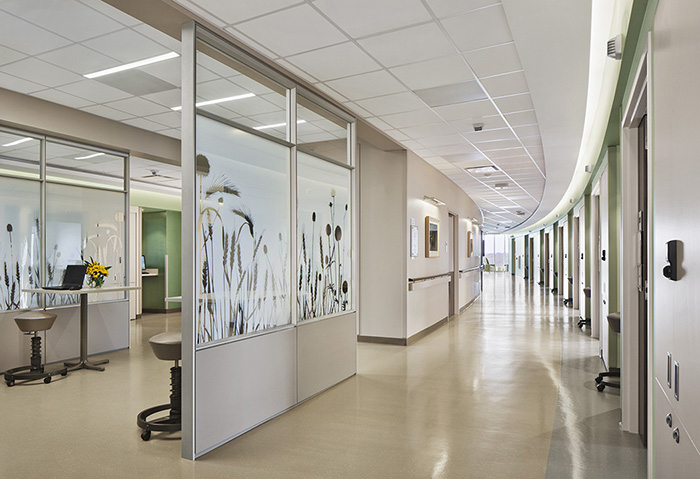Does decentralized nursing unit design work?

LAWRENCE — Modern hospital design — with all-private patient rooms, larger units and decentralized nursing stations – has raised concerns about nurses walking long distances and failing to maintain proximity to patients.
 The supposed benefit of decentralizing nurses’ stations is to afford more time at the patient bedside, less walking distance and better patient care. However, this trend may have unintended consequences.
The supposed benefit of decentralizing nurses’ stations is to afford more time at the patient bedside, less walking distance and better patient care. However, this trend may have unintended consequences.
Based on research conducted by faculty in the Institute for Health + Wellness Design at the University of Kansas School of Architecture, Design & Planning, there are complex issues related not only to efficiency but also to the social and support needs of the nursing staff.
Three Institute for Health + Wellness faculty members — Assistant Professor Hui Cai, Professor Kent Spreckelmeyer and Institute Chairman Frank Zilm — presented a collaborative decentralized nursing unit study with Lawrence Group and SSM Health System at the Healthcare Design Conference 2016 in Houston, which is the largest annual conference in the health care design industry.
 The KU-alumni founded architecture firm Lawrence Group, which is based in St. Louis, engaged the KU IHWD team to review the 2014 renovation of the orthopedic unit at SSM St. Mary’s Hospital in Jefferson City, Missouri, with the goal of informing a planned expansion of its SSM St. Joseph Hospital West in Lake St. Louis, Missouri.
The KU-alumni founded architecture firm Lawrence Group, which is based in St. Louis, engaged the KU IHWD team to review the 2014 renovation of the orthopedic unit at SSM St. Mary’s Hospital in Jefferson City, Missouri, with the goal of informing a planned expansion of its SSM St. Joseph Hospital West in Lake St. Louis, Missouri.
“KU is a neutral, third-party academic institute,” Cai said. “We provide rigor and objectivity when conducting post-occupancy evaluation. POE is not a new concept, but traditionally POE was conducted in an indicative way — as gaining client feedback. Evidence-based design is a rapidly growing field in health care due to the implementation of evidence-based medicine. With the increasing focus on EBD, there is a much higher expectation in proving the value of design using credible evidence. Therefore, in this project, Lawrence Group — one of the IHWD affiliate member firms — engaged the IHWD as academic research consultants to provide scientific approaches to help them conduct investigative POE to link design with goals on patient safety, staff efficiency and financial outcomes.”
 Cai said the institute looked at the unit using an EBD checklist promulgated by the California-based nonprofit Center for Health Design. In addition, Cai said, the study included a “space syntax” evaluation that generated a heat map of visual connectivity of the layout and patient-satisfaction surveys.
Cai said the institute looked at the unit using an EBD checklist promulgated by the California-based nonprofit Center for Health Design. In addition, Cai said, the study included a “space syntax” evaluation that generated a heat map of visual connectivity of the layout and patient-satisfaction surveys.
“We wanted to see does moving into a new facility improve patient satisfaction scores, which is one of the most important things for hospital owners today,” she said.
The survey found that “all questions about the facility showed a statistically significant increase in score after the renovation,” Cai said. “On questions of patient-care quality, most stayed the same, but one dropped slightly, and that was nurses’ response to patient calls. Our hypothesis is that this is because of decentralized nurses’ stations, so we are planning a second phase of study to follow up on that question: “How does that decentralized design impact nurses’ communication and teamwork, and thus the patients’ perception?”
 Cai explained that about a decade ago, the trend away from one central nurses’ station per floor began, coinciding with the growth of health care IT and electronic medical records. The notion was to place nurses closer to patients’ rooms so that they could keep an eye on their charges while charting. Her hypothesis is that, due to the physical distance and visual disconnection of decentralized nursing unit design, nurses now have to move farther among the decentralized stations to consult with their peers, perhaps leading to less communication and collaboration, delays in response to patients and patient dissatisfaction.
Cai explained that about a decade ago, the trend away from one central nurses’ station per floor began, coinciding with the growth of health care IT and electronic medical records. The notion was to place nurses closer to patients’ rooms so that they could keep an eye on their charges while charting. Her hypothesis is that, due to the physical distance and visual disconnection of decentralized nursing unit design, nurses now have to move farther among the decentralized stations to consult with their peers, perhaps leading to less communication and collaboration, delays in response to patients and patient dissatisfaction.
“We are calling for attention to this design feature,” Cai said. “This design trend needs to be further investigated before it is accepted as standard for every hospital. We have to see how to modify the design to achieve balance between shorter walking distance, better patient surveillance and better staff communication and collaboration. … Hopefully through the research, we can provide design recommendations for alternative models, possibly hybrid, with team bases that have that sense of a small group without losing the close adjacency to patient rooms.”
With the support of KU’s New Faculty General Research Fund, a group of KU students has worked with Cai to conduct a second-phase study on the effects of decentralized nurse stations on nurses’ communication and patient satisfaction. During the summer of 2016, she added a second hospital – the University Medical Center of Princeton at Plainsboro, New Jersey – to the data set. The researchers conducted in-depth, onsite observation, behavior mapping, tracking, focus-group interviews and surveys in these hospitals. Cai plans to present and publish her findings in late 2017.
The hope is that these projects will provide great insights into hospitals and the design industry with evidence regarding the innovative yet debatable design feature of decentralized nurses’ stations. The research is one of the few studies that link decentralized nurse station design with actual organizational performances and patient outcomes, such as nurse-turnover rate and patient satisfaction. Importantly, too, the projects provide a great learning opportunity for KU students to do post-occupancy evaluations, which is highly sought after in the design field.